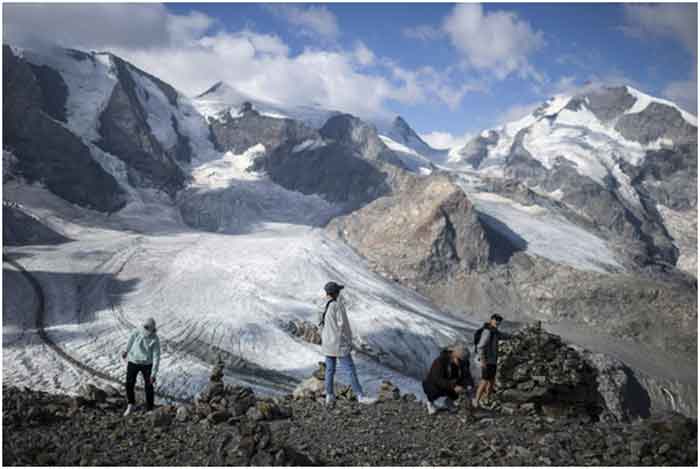
Switzerland’s glaciers are melting like never before, found a study. Switzerland has the greatest volume of glaciers of any country in Europe.
The study, released Wednesday, found with the glaciers’ ice volume declining by 6% this year amid rising concerns about global warming and a summer heat wave that swept across Europe.
Media reports said:
The Swiss Academy of Sciences reported that the shrinkage of ice in the country’s glaciers topped a previous record retreat nearly a generation ago.
“2022 was a disastrous year for Swiss glaciers: all ice melt records were smashed by the great dearth of snow in winter and continuous heat waves in summer,” the academy said in a statement.
The academy based its report on data collected by Glamos, the Swiss glacier-monitoring network.
Matthias Huss, a glaciologist with the Federal Polytechnic Institute in Zurich who heads the Glamos program, says there is “zero chance” the glaciers will return for decades — at best — given current projections for global temperatures.
“We have a series reaching back for more than 100 years, and we have never seen anything that is comparable to this year,” he said by phone. “It is something that has been expected for the future that such extremes might come along, but now they are already here.”
Switzerland faced an “unlucky combination of factors” this year that led to the big melt, Huss said. Snow cover in the Swiss Alps was exceptionally light, particularly in the southeast, meaning that the glaciers had less natural protection from the heat.
An AP report said:
A dust drift from the Sahara then blanketed many parts of Europe in the spring, causing the snow to absorb more solar heat. A spike in summer temperatures across Europe further intensified the glacial melt.
The findings come on top of another study released last month showing that Switzerland’s 1,400 glaciers have lost more than half their total volume since the early 1930s.
The report issued Wednesday chronicles in detail the damage across the Swiss Alps: Over 6 meters (19.6 feet) of ice melted this year on the Konkordiaplatz summit in the Great Aletsch Glacier in the south, near the Italian border.
Small glaciers like Pizol in the east near Liechtenstein, Vadret dal Corvatsch near St. Moritz in the southeast, and Schwarzbachfirn in central Switzerland have “practically disappeared,” the team said.
Elsewhere in Europe, the Bavarian Academy of Sciences in Germany said the ice sheet on the Southern Schneeferner in the Alps melted so much this summer that it could no longer be considered a glacier — leaving Germany now with only four glaciers.
Huss said that while people are not acting quickly enough to curb global warning, he thinks the world is waking up to the threat and the need to reduce emissions of greenhouse gases that trap heat in the atmosphere.
“The world’s leaders have at least realized that something needs to be done to prevent the negative impacts of climate change,” he said. ‘But still, I feel that not enough is actually been implemented of the plans that are around. But at least it’s better to have a plan and to strive and reduce greenhouse gas emissions than to not speak about it.”
Already shrunk by half, Swiss glaciers melting faster
Another report said:
Switzerland’s 1,400 glaciers have lost more than half their total volume since the early 1930s, a new study has found, and researchers say the ice retreat is accelerating at a time of growing concerns about climate change.
ETH Zurich, a respected federal polytechnic university, and the Swiss Federal Institute on Forest, Snow and Landscape Research on Monday announced the findings from a first-ever reconstruction of ice loss in Switzerland in the 20th century, based in part on an analysis of changes to the topography of glaciers since 1931.
The researchers estimated that ice volumes on the glaciers had shrunk by half over the subsequent 85 years — until 2016. Since then, the glaciers have lost an additional 12%, over just six years.
“Glacier retreat is accelerating. Closely observing this phenomenon and quantifying its historical dimensions is important because it allows us to infer the glaciers’ responses to a changing climate,” said Daniel Farinotti, a co-author of the study, which was published in scientific journal The Cryosphere.
By area, Switzerland’s glaciers amount to about half of all the total glaciers in the European Alps.
The teams drew on a combination of long-term observations of glaciers. That included measurements in the field and aerial and mountaintop photographs — including 22,000 taken from peaks between the two world wars. By using multiple sources, the researchers could fill in gaps. Only a few of Switzerland’s glaciers have been studied regularly over the years.
The research involved using decades-old techniques to allow for comparisons of the shape and position of images of terrain, and the use of cameras and instruments to measure angles of land areas. The teams compared surface topography of glaciers at different moments, allowing for calculations about the evolution in ice volumes.
Not all Swiss glaciers have been losing ice at the same rates, the researchers said. Altitude, amounts of debris on the glaciers, and the flatness of a glacier’s “snout” — its lowest part, which is the most vulnerable to melting — all affect the speeds of ice retreat.
The researchers also found that two periods — in the 1920s and the 1980s — actually experienced sporadic growth in glacier mass, but that was overshadowed by the broader trend of decline.
The findings could have broad implications for Switzerland’s long-term energy sources, since hydropower produces nearly 60% of the country’s electricity, according to government data.














































